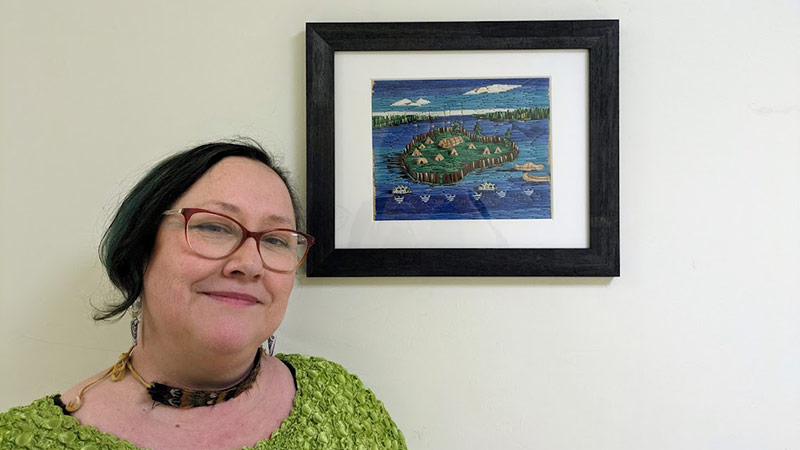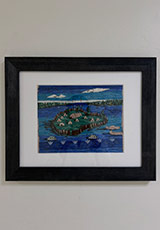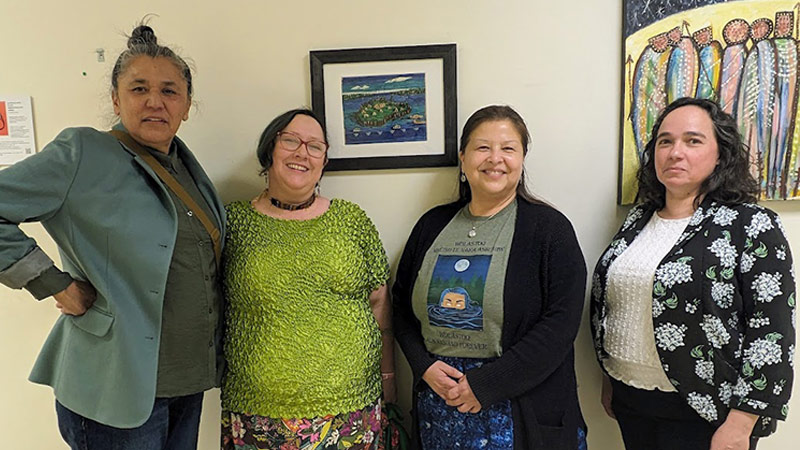Artist Tara Francis tells the story of once forgotten Wolastoqey island in the Menahkwesk (Saint John) harbour
Author: Kayla Cormier
Posted on Jun 28, 2024
Category: UNB Saint John

On April 11, 2024, an unveiling celebration was held in Hazen Hall for artwork by Mi’kmaq artist Tara Francis, commissioned by the faculty of arts at the University of New Brunswick (UNB) in Saint John.
In this new work, Tara tells the interconnected and intergenerational histories of the Menahkwesk (Saint John) harbour. It depicts a small island village where Indigenous ancestors met and shared resources while moving across the Wabanaki homelands with comfort and ease. That island now exists as a mound of earth on which a pillar for the Harbour Bridge sits.
The title of the piece is oetjgoa’tigemg—which translates to English as “the days past." It showcases Tara’s contemporary take on the Mi’kmaq tradition of porcupine quill art.
The event was a wonderful commemoration for Tara’s work which brought many students and community members together to learn more about its inspiration and history. Elder Ramona Nicholas lit a smudge and filled the space with the traditional Wolastoq song—singing to the river depicted in Tara’s piece.
Gina Brooks, a traditional Wolastoqey artist from Sitansisk (St. Mary’s First Nation), shared the teaching of the treaties and gave everyone in attendance salt harvested from the ocean here to remind them that we’re all connected by water—another theme in oetjgoa’tigemg.
The idea for oetjgoa’tigemg came from several colonial documents brought to Tara’s attention by colonial literary historian and professor, Dr. Rachel Bryant and Elder Ramona Nicholas. In these manuscripts, a village island is described at the mouth of the Wolastoq River—just below what is now known as the Reversing Falls. The earliest of the source documents dates back to 1607.

Tara's work tells the story of this island and how it was a place for gathering and interaction amongst Wabanaki tribes throughout history. Despite being a Wolastoqey island (sitting in the Wolastoq River), it was a meeting place for Wabanaki peoples from different territories.
“Mi’kmaq people would travel down the river system from Gespe’gewa’gi, portage behind what is now the New Brunswick Museum, and come to the island to meet and replenish supplies, before going out to the harbour and around to Nova Scotia,” said Tara.
Oetjgoa’tigemg is a vibrant eight by ten-inch piece, which Tara noted, “doesn’t seem that big, but when you’re working with materials that are, you know, a millimeter wide… that makes things more challenging.”
The process is both time consuming and meditative. She removes quills from porcupine carcasses and begins the washing and dyeing process for each quill. Birch bark is used as the base, where she pokes holes in the bark, pulling each quill through with tweezers “over and over and over again,” Tara laughed. “It took about 200 hours.”
“There are different elements in oetjgoa’tigemg that the historical documents specify. One talks about how there are so many whales in the harbour, and how the writer is disgusted by the so-called whale breath,” Tara explained.
“In the piece you’ll see there are two whales that address that commentary. One is darker and more pronounced; the other is there but not there. This speaks to the depletion of the whales and how they’re not as plentiful in the harbour as they once were.”
Oetjgoa’tigemg also includes turtles napping on the shoreline, a detail mentioned in one of the manuscripts. Tara notes that her very first porcupine quill piece was a turtle.
“They carry through my work and have become symbolic of my own journey. That slowness and perseverance. My own personal totem if you will,” she said.
“If you look carefully, you’ll see an outline of the Harbour Bridge there too,” addressing what has become of the village today. Tara hopes that people who learn of this island through her artwork will acknowledge the history moving forward.
“The next time you go over the harbour bridge, you might think about it a bit differently.”
When asked about her inspirations as an artist, Tara reflected, “In more recent years I’ve been inclined to create a narrative around what we’re going through as Indigenous Peoples. My work is part spirit and part reaction. As an Indigenous artist, I have a platform and a voice and I can use it to address those issues.”
“I’m a contemporary artist living and reacting to today. We’re not just museum pieces living under glass. We’re a thriving people working with our traditional materials and living in today’s world. It kind of follows that idea of two-eyed seeing.”

Dr. Rachel Bryant, in collaboration with Elder Ramona Nicholas, sourced the historical documents about the Menahkwesk harbour for this commission. She spoke about the importance of Tara’s piece for bringing this history back into our collective consciousness.
“Here in Saint John, we often think we’ve totally paved over and replaced all that history… We forget the island. We forget the village. We forget the whales. We forget the turtles.”
Despite being embedded in French and Scottish colonial documents, there are stories to be told about this island.
“Tara’s piece shares this Wabanaki story,” said Dr. Bryant. “I have stories in these documents too—that’s the colonial part.”
She credits Elder Ramona’s scholarship for helping her conceptualize the idea that, in every historical document from this territory, there is a boundary between non-Indigenous and Indigenous Peoples.
“I am grateful to be able to help pull this information out from these violent contexts and to work with artists like Tara, who can then tell this story in a way that’s beautiful… and removed from those colonial contexts. Now this history is accessible to Wabanaki students in a way that’s not going to hurt them,” she said.
“It’s important for Indigenous students to see reflections of themselves and their ancestors on campus. And for settlers to always remember whose land this is and how we got here. To feel connection to these histories and to one another.”
Elder Ramona Nicholas, who is the foremost archeologist for the Wolastoqiyik, and who has ties to UNB, played a pivotal role in facilitating the commission and the unveiling.
“I’ve admired Tara’s work for a long time, and I was honoured to go through that process with her” she said.
Ramona expressed that the history of this island holds a lot of meaning to her.
“My ancestors were there. It was a meeting place, and it was recognized that Mi’kmaq and Wolastoqiyik Peoples were there together,” she reflected. “It wasn’t about ‘this is my territory and that’s yours.’ It was a coming together to share resources. To be in a space where there was no conflict.”
Ramona also highlights the wider implications of this piece.
“Even though there is division today about... this is Mi’kmaq territory and this is Wolastoqiyik territory... to me, what matters most is that it’s Wabanaki territory.”
She continues to talk about the Indian Act and how the Reservation system was imposed on Wabanaki Peoples and what that meant for them.
“It disconnected us from one another, from the land and from our places of origin,” she said.
“If we want to continue on our path in a good way, we need to recognize this. More than, you know, pointing fingers at one another. Underneath all of this, we’re Wabanaki.”
Oetjgoa’tigemg is now hanging permanently in Hazen Hall. All members of the UNB community are encouraged to view it in-person and to reflect on our shared colonial history.
Visit IndigenEast Art Studios to learn more about Tara and her work.
